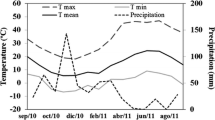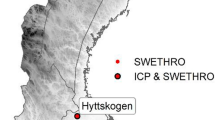Abstract
A growth model ofPhragmites australis was verified using two independent sets of published field data. The model simulates the growth pattern of a well-established, monospecific stand ofP. australis in the absence of genetic diversity and environmental stresses of mainly nutrient and water deficiency. The model formulated using first order differential equations was combined with plant phenology and comprises five subroutines in which photosynthetically active radiation, shoot, root, rhizome and new rhizome biomass are calculated. Using the model, experimental results were reproduced within reasonable limits having concordance correlation coefficients of more than 0.75 for 70% of the output parameters, which was the main objective of the study. The modelled efficiencies of PAR were 7.15% and 3.09%, as opposed to 7.7% and 2.53% in experimental estimations, for Loch of Forfar and Loch of Balgavies, respectively. Production and seasonal fluxes of dry matter ofP. australis in Scottish lochs were estimated using the modelled quantities for the 1975 growing season in g m−2. They showed that 31% and 37% of total net photosynthate translocated to rhizomes before shoot senescence began in Loch of Forfar and Loch of Balgavies, respectively. Also in both lochs approximately 45% of total downward translocation came from accumulated shoot dry matter during senescence, while the rest came from photosynthesis before the shoots started to senesce.
Similar content being viewed by others
References
Allirand J.M. &Gosse G. (1995): An above ground biomass production model for a common reed (Phragmites communisTrin.) stand.Biomass & Bioenergy 9: 441–448.
Anderson F.O. (1976): Primary production in a shallow water lake with special reference to a reed swamp.Oikos 27: 243–250.
Armstrong W. &Beckett P.M. (1987): Internal aeration and the development of stelar anoxia in submerged roots. A multishelled mathematical model combining axial diffusion of oxygen in the cortex with radial losses to the stele, the wall layers and the rhizosphere.New Phytol. 105: 221–245.
Asaeda T. &Bon T.V. (1997): Modelling the effects of macrophytes on algal blooming in eutrophic shallow lakes.Ecol. Modelling 104: 261–287.
Asaeda T. &Karunaratne S. (2000): Dynamic modelling of the growth ofPhragmites australis: Model description.Aquatic Bot. 67(4): 301–318.
Asaeda T., Trung V.K. &Manatunge J. (2000): Modelling the effects of macrophyte growth and decomposition on the nutrient budget in shallow lakes.Aquatic Bot. 68: 217–237.
Čížková H. &Bauer V. (1998): Rhizome respiration ofPhragmites australis: Effect of rhizome age, temperature, and nutrient status of the habitat.Aquatic Bot. 61: 239–253.
Čížková H., Strand J.A. &Lukavská J. (1996): Factors associated with reed decline in a eutrophic fishpond, Rožmberk (South Bohemia, Czech Republic).Folia Geobot. Phytotax. 31: 73–84.
Čížková-Končalová H., Květ J. &Thompson K. (1992): Carbon starvation: a key to reed decline in eutrophic lakes.Aquatic Bot. 43: 105–113.
Dykyjová D. (1971): Production, vertical structure and light profiles in littoral stands of reed-bed species.Hydrobiologia 12: 361–376.
Dykyjová D. &Hradecká D. (1976): Production ecology ofPhragmites communis. 1. Relations of two ecotypes of the macroclimate and nutrient conditions of habitat.Folia Geobot. Phytotax. 11: 23–61.
Dykyjová D., Ondok P.J. &Hradecká D. (1972): Growth rate and development of the root/shoot ratio in reedswamp macrophytes grown in winter hydroponic cultures.Folia Geobot. Phytotax. 7: 259–268.
Dykyjová D. &Přibil S. (1975): Energy content in the biomass of emergent macrophytes and their ecological efficiency.Arch. Hydrobiol. 75: 90–108.
Dykyjová D., Verber K. &Přibáň K. (1971): Productivity and root/shoot ratio of reedswamp species growing in outdoor hydroponic cultures.Folia Geobot. Phytotax. 6: 233–254.
Fiala K. (1973): Growth and production of underground organs ofTypha angustifolia L.,Typha latifolia L. andPhragmites communisTrin.Polsk. Arch. Hydrobiol. 20: 59–66.
Hara T., van der Toorn J. &Mook J.H. (1993): Growth dynamics and size structure of shoots ofPhragmites australis, a clonal plant.J. Ecol. 81: 47–60.
Ho Y.B. (1979): Shoot development and production studiesof Phragmites australis (Cav.)Trin. ex.Steudel in Scottish Lochs.Hydrobiologia 64: 215–222.
Ho Y.B. (1981): Mineral composition ofPhragmites australis in Scottish Lochs as related to eutrophication. I. Seasonal changes in organs.Hydrobiologia 85: 227–237.
Hocking P.J. (1989): Seasonal dynamics of production, and nutrient accumulation and cycling byPhragmites australis (Cav.)Trin. exSteudel in a nutrient-enriched swamp in inland Australia. I. Whole plants.Austral. J. Mar. Freshwater Res. 40: 445–64.
Hootsmans M.J.M. (1994): A growth analysis model forPotamageton pectinatus L. In:Vierssen W.V., Hootsmans M.J.M. &Vermaat J. (eds.),Lake Veluwe, A macrophyte-dominated system under eutrophication stress, Kluwer Academic Publishers, Dordrecht, pp. 250–286.
Kubín P. &Melzer A. (1996): Does ammonium affect accumulation of starch in Rhizomes ofPhragmites australis (Cav.)Trin. ex.Steud.?Folia Geobot. Phytotax. 31: 99–109.
Kubín P., Melzer A. &Čížková H. (1994): The relationship between starch content in rhizomes ofPhragmites australis (Cav.)Trin. ex.Steud. and tropic conditions of habitat.Proc. Roy. Soc. Edinburgh, B 102: 433–438.
Květ J. (1971): Growth analysis approach to the production ecology of reedswamp plant communities.Hydrobiologia 12: 15–40.
Květ J., Svoboda J. &Fiala K. (1969): Canopy developments in stands ofTypha latifolia L. andPhragmites communisTrin. in South Moravia.Hydrobiologia 10: 63–75.
Lytle R.W. &Hull R.J. (1980): Photoassimilate distribution inSpartina alternifloraLoisel. 1. Vegetative and floral development.Agron. J. 72: 933–938.
Rea N. (1996): Water levels andPhragmites: Decline from lack of regeneration or die-back from shoot death.Folia Geobot. Phytotax. 31: 85–90.
Schierup H.-H. (1978): Biomass and primary production in aPhragmites communisTrin. swamp in North Jutland, Denmark.Int. Vereinigung Theor. Limnol. Verh. 20: 94–99.
Sieghardt H. (1973): Utilization of solar energy and energy content of different organs ofPhragmites communisTrin.Polsk. Arch. Hydrobiol. 20: 151–156.
Szajnowski F. (1973a): The relationship between leaf area index and production of the aboveground parts of common reed (Phragmites communisTrin.).Polsk. Arch. Hydrobiol. 20: 157–158.
Szajnowski F. (1973b): The relationship between leaf area index and shoot production of the aboveground parts of common reed (Phragmites communisTrin.).Polsk. Arch. Hydrobiol. 20: 257–268.
Author information
Authors and Affiliations
Corresponding author
Rights and permissions
About this article
Cite this article
Karunaratne, S., Asaeda, T. Verification of a mathematical growth model ofPhragmites australis using field data from two scottish lochs. Folia Geobot 35, 419–432 (2000). https://doi.org/10.1007/BF02803553
Received:
Revised:
Accepted:
Issue Date:
DOI: https://doi.org/10.1007/BF02803553




